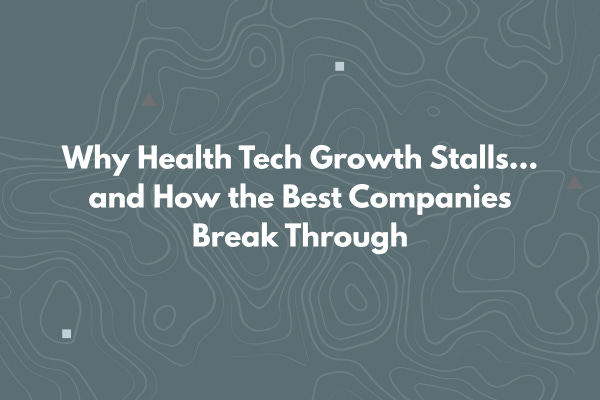Why Health Tech Growth Stalls and How the Best Companies Break Through
Growth doesn't usually stall all at once. It fades in stages.
Pipelines thin, deals drift longer, and buyers who once moved quickly start hesitating without ever naming why.
Competition and market shifts are real threats in health tech.
But just as often, growth slows because the internal system never evolves fast enough to keep pace with early wins.
The good news?
Growth doesn't stall randomly.
It breaks down at predictable inflection points. And if you know where to look, you can fix the system before momentum disappears.
Here are the three common stages where growth pressure shows up and how the best companies stay ahead of it.
Inflection Point 1: Early Wins Without a Scalable Motion
What Companies at This Stage Look Like
The early days feel electric. Founders, early sellers, and anyone who can spell “revenue” are out chasing deals. Everyone moves fast, says yes to everything, and stitches together wins however they can.
No one’s worried about formal processes yet because deals are closing, the logo count is growing, and momentum feels like it's everywhere. The energy is real.
But beneath it, every deal looks a little different. Every buyer hears a slightly different story. And slowly, cracks start forming that no one’s focused on yet.
Where Things Stall
Success depends heavily on individual effort, not a shared system
New hires struggle because there’s no clear path to replicate success
Buyers experience inconsistent messaging and buying journeys
Forecasts become unreliable because deals don't follow a predictable shape
How Smart Companies Beat It
Anchor the pitch around a core narrative that works across reps and deals
Build a first version of a real sales motion, even if it’s rough
Define simple stages, handoffs, and buyer milestones that can scale
Consistency and reproducibility become the new success metrics
Inflection Point 2: Leaning on Top Performers Instead of Building a Team Motion
What Companies at This Stage Look Like
A few great sellers are driving the ship. They know how to talk to buyers. They know how to move deals. They’re winning and the company is growing.
Internally, there’s pride in how strong the team is.
The narrative sounds like:
“We have some really sharp people.” “They just get it.”
Deals feel personal, relationships matter, and the wins keep coming.
But underneath the pride, cracks start to show. Growth depends too much on individuals. Success lives in heads, not systems. And when the next wave of hires comes in, they struggle to match the performance that once felt automatic.
Where Things Stall
The team depends on tribal knowledge and intuition instead of a defined process
New hires fail to ramp because success isn’t codified or transferable
Messaging and buyer journeys vary wildly depending on which rep owns the deal
Pipeline forecasting becomes unreliable because deal flow is inconsistent
How Smart Companies Beat It
Capture the patterns: document how top reps are actually closing deals, not what they say they do
Standardize key stages, milestones, and proof points buyers need to move forward
Build onboarding that teaches the real motion, not just product knowledge
Shift leadership focus from celebrating individual heroics to reinforcing consistent execution across the team
Inflection Point 3: Expanding Your Products Without Rebuilding Your Message
What Companies at This Stage Look Like
The company is bigger now. There are new customers, new products, maybe even an acquisition or two. The success that once came from sharp focus now feels like it could expand everywhere.
New markets. New buyers. New possibilities. Internally, it’s exciting and it should be!
But the story that once landed with clarity starts to blur. Instead of one clean message, there’s now a flood of new capabilities, new features, and new promises.
Buyers who once quickly understood what made the company different now feel overwhelmed or confused. Success created expansion. However, it also created a gap between what the company is trying to say and what the buyer is ready to hear.
Where Things Stall
Messaging becomes bloated, trying to speak to every product and every buyer at once
New product launches dilute attention, pulling focus from the core story
Sales cycles stretch out as buyers struggle to understand what matters most
Teams chase too many types of opportunities, spreading resources thin and confusing execution
How Smart Companies Beat It
Re-center around the evolved Ideal Customer Profile (ICP): define who you serve best now, not who you started with
Prioritize messaging around the buyer’s true needs, not every feature or capability
Equip sales teams to guide buyers clearly, focusing conversations and qualifying hard
Align product, marketing, and sales tightly to the refined focus so momentum compounds
Final Thought
Growth doesn't collapse overnight. It stalls quietly when the system that powered early wins doesn’t evolve fast enough to support the next stage.
The vendors that break through don’t just work harder. They catch the early signs of strain, and they build ahead of it before momentum slips away.
You already have an advantage most don’t.
You know where the real inflection points are.
You know how to spot the signals.
And now you know what to strengthen before it ever becomes a stall-out.
That’s the difference between hoping growth continues and building a company designed to keep earning it.
🔒 Like This? Upgrade to a paid Subscription.
The free newsletter covers the big ideas. Paid subscribers get the full breakdowns, including client-tested strategy, behind-the-scenes examples, and deeper thinking you won’t find anywhere else.
→ [Become a Paid Subscriber]
About the Author
Ryan Peterson writes Upward Growth, where he shares practical insights on selling health tech into the payor market. With 15+ years in healthcare growth leadership, he focuses on helping vendors translate their value into traction with health plans.
🟦 Connect with him on LinkedIn.


